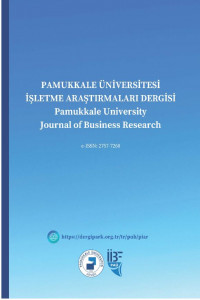Research Article
Opinion Letter
Aim & Scope
Pamukkale University Journal of Business Research aims to publish academic research at national and international level and contribute to science. The journal is an open access journal and aims to provide easy and unlimited access to scientists and readers. The journal aims to publish two issues a year.
Pamukkale University Journal of Business Research (PIAR) is an international refereed journal. Pamukkale University Journal of Business Research covers the publication of articles from the fields of Economics and Administrative Sciences, especially in the fields of Business, Public sector and Management. The journal aims to publish research and theoretical articles in the fields of public and private sector and to make them available to scientists.
Author Guidelines
AUTHOR GUIDELINES
General Rules
1. Manuscripts written in Turkish and English are published in Pamukkale University Journal of Business Research (PIAR) submitted should include both Turkish "Abstract" and English "Abstract".
2. Writer(s) accept(s) that the manuscript is original, and it has not been sent to another journal to be published and it has not published before.
3. The studies that are requested to be evaluated in the journal should be uploaded via Dergipark (https://dergipark.org.tr/tr/pub/piar) in accordance with the conditions stated in the journal writing rules. It is necessary to select the Submit Article button and follow the necessary steps and upload the article and other necessary information and documents to the system.
4. The name-surname, institution, e-mail and ORCID information of the author or authors should be included in all files uploaded to the system. This information about the author or authors is deleted by the journal editor during the evaluation process within the framework of blind review principles.
5. If the article is derived from any thesis or other scientific study, it should be shown in a footnote to the title of the article on the first page of the article.
6. Manuscripts should be submitted as Microsoft Word file (minimum version is Microsoft Office Word 2010)
7. Authors should analyze their manuscripts with similarity programs such as iThenticate or Turnitin and upload the analysis report to the system. Plagiarism rate is expected to be less than 20%.
8. If there are legal reasons that prevent the sharing of data sets, analysis outputs and data used in the analysis in the articles, the documents showing this must be uploaded to the system. The authors agree in advance that the datasets or analysis outputs they upload can be audited.
9. Manuscripts should be maximum 25 (twenty-five) pages including everything.
10. Page layout, A4 size; It should be: Top: 3 cm, Bottom: 3 cm, Left: 2.5 cm, Right: 2.5 cm, Header: 1.25 cm, Footer: 1.25 cm.
11. Palatino Linotype (Times New Roman font, if not installed) font should be used in manuscripts.
12. Copyright Form must be signed by the corresponding author and uploaded to the system.
13. The Editorial Board is entitled to request correction on any form of condition not covered by this directive.
Main Text Writing Rules
1. The first page of the article should be prepared in the following rules in order:
• Title: Its size should be 12 pt, bold, centered, before 12 pt, after 6 pt, the first letter of the words should be capital and maximum of twelve (12) words (APA style).
• Authors’ names: Its size should be 11 pt, centered, 0 pt before and 6 pt after, and title should not be used. The last name must be in capital letters, followed by institution information, e-mail addresses and ORCID numbers. Multiple authors should not be written side by side on the same line.
• Abstract (in Turkish): The text should contain no text carriage indent (size 9 pt, 0 pt before and after, italic, justified), the subject of the study, its purpose, methodology, and notable findings and should contain a minimum of 100 and a maximum of 180 words.
• Key words: (size 9 font, bold, before and after 6 pt spacing) should be written next to the title at least 3 and at most 5.
• JEL Codes: (size 9 point, bold, italic, before and after 6 pt interval) It is obligatory to give JEL codes in studies related to operation and economy.
• Title in English: Its size should be 12 points, bold, centered, only the first letter of the first word should be capital, 0 pt before, 6 pt after.
• Abstract: It should be the same content as the Turkish abstract text without any carriage indent (size 9 pt, 0 pt before and after, italic, justified).
• Keywords: Size (9 point, bold, before and after 6 pt spacing) should be just below the Abstract and the same as Turkish keywords.
• JEL Codes: (size 9 point, bold, italic, before and after 6 nk spacing) Must be given immediately after JEL Codes Keywords.
• If the submitted article is written in English, the order is: Article Name (English) -Author Information- Abstract- Keywords-JEL Codes- Article Name (Turkish) - Abstract (Turkish) - Keywords (Turkish) - JEL Codes.
2. The main text should be 11 pt starting from the INTRODUCTION section including all titles and a single line spacing should be used.
3. The titles in the article should be numbered. All of the main titles must be in capital letters, 11 points, bold, left aligned, before and after 6 pt. In the subtitles, the first letter of each word must be uppercase and the others must be lowercase.
Example:
1. INTRODUCTION
2. ORGANIZATIONAL SUPPORT
2.1. The Features of Organizational Support
4. Paragraphs must be 11 pt, justified, 0 and 6 pt before and without line indent.
5. Each of the tables, figures and graphics to be included in the text should be titled so as not to overflow the page margins (if the page margins are smaller than the tables, figures and graphic, the page should be centered) and by giving a heading (numerical) title number.
6. The font size of the text in the table, graphic and figure cannot be less than 9 points and larger than 11 points.
Table headings should be at the top of the table and start in line with the table. Table titles should be created as "Table 1. Title appropriate to the content of the table".
Example
Table 1. Title appropriate to the content of the table
Örgütsel Destek 1-Önemsenme 2-Kurum Toleransı
1.Çalıştığım kurum benim iyiliğime önem verir. ,835 ,87
2.Çalıştığım kurum hedef ve değerlerimi kesinlikle dikkate alır. ,900 ,84
7. Figure and graphic titles should be at the bottom. The references of the tables, figures and graphics to be included in the text should be placed under the tables, figures and graphics in accordance with the in-text reference rules. Source: DPT, 1988: 125
8. Decimal fractions should be separated by commas in the article, the equations used should be numbered and these numbers should be at the far right of the page in parentheses. Equation Editor of MS Word should be used in mathematical expressions and should not be pasted as a picture.
9. Spelling rules should be observed in the text. Turkish Language Association spelling rules apply. For example, since the Turkish Language Association accepts the word “Internet” as a private name, this word should be used in Turkish writings in accordance with the specific name language rules.
10. If there is author in internet references, these references should be listed on the basis of access dates, under the heading “Internet References”, after the references list.
Citation and Footnote Writing Rules
1. In the Pamukkale University Journal of Business Research (PIAR), only the in-text citation system should be used, and the reference system with author surname, date and page numbers should be preferred in citations (Ex: Clegg, 1997: 53).
2. In the references to sources with more than two authors, the surname of the first author and "et al." must be used (Ex: Morgan et al., 1994: 75).
3. If more than one source is used in the same parenthesis, the sources must be separated with a semicolon (;) sign (For example: Hassard and Parker, 1994: 125; Boje, 1996: 146).
4. In the quotations given from the work published by an author in the same year, the quotations should be separated into a and b. (Ex: Kazgan, 2016a: 125; Kazgan, 2016b: 256).
5. Explanations about some issues to be explained in the text can be specified as footnote at the bottom of the page. Footnotes should be numerically justified, single line spacing and 9 points.
References Writing Rules
1. Reference Palatino Linotype, 11 font size, single line spacing should be used and justified.
2. Footnote or endnote should not be preferred in References.
Article examples:
Author Surname, Name. (Year). Article Name. The name of the journal, Volume (Number), Pages.
Single author article in foreign language (other than Turkish):
LeDoux, J. E. (1995). Emotion: Clues from the brain. Annual Review of Psychology, 46, 209–235.
Article with two authors written in a foreign language:
Authors should be separated by "&"
Carstensen, L. L. & Mikels, J. A. (2005). At the intersection of emotion and cognition: Aging and the positivity effect. Current Directions in Psychological Science, 14(2), 117–121
Articles with more than two authors written in a foreign language: previous authors with commas; the last author should be separated by "&"
Anderson, A. K., Christoff, K., Panitz, D., De Rosa, E., & Gabrieli, J. D. E. (2003). Neural correlates of the automatic processing of threat facial signals. Journal of Neuroscience, 23(1), 5627–5633.
Single author article in Turkish:
Akın, M. (2019). Ürün, Kullanıcı ve Müşteri Odaklı Yaklaşımların Karşılaştırılması. Pamukkale İşletme ve Bilişim Yönetimi Dergisi, 6 (1), 35-46.
Articles written in Turkish with two authors: Must be separated with "and"
Sarıkaya, M. ve İrmiş, A. (2015). Geçiş Sürecinde Halk Sektörü Girişimciliği. Pamukkale İşletme ve Bilişim Yönetimi Dergisi, 2(2), 27-36.
Articles with more than two authors written in Turkish: previous authors with commas; the last author should be separated by "and".
Uslu, B., Gür, Ş., Eren, T. ve Özcan, E. (2020). Çok Kriterli Karar Verme Yöntemleri ile Bulut Hizmet Sağlayıcı Sıralaması. Pamukkale İşletme ve Bilişim Yönetimi Dergisi, 6(1), 20-34.
Book examples:
Author Surname, Name. (Year). Title of the Book. City: Publisher.
The separation of author names is the same as in the article display.
Turkish book with a single author
Saraç, M. (2017). Finans Teorisini Yeniden Düşünmek. İstanbul: İktisat Yayınları.
English book with a single author
Shipley, W. C. (1986). Shipley Institute of Living Scale. Los Angeles, CA: Western Psychological Services.
Turkish book with two authors
Can, H. ve Güner S. (1992). Açıklamalı, İçtihatlı Turizm Hukuku ve Mevzuatı. Ankara: Feryal Matbaacılık.
English book with two authors
Carstensen, L. L. & Mikels, J. A. (2005). Book Name. City: Publisher.
Turkish book with more than two authors
Uslu, B., Gür, Ş., Eren, T. ve Özcan, E. (2020). Kitap Adı. Şehir: Yayınevi.
Internet examples
Devlet Planlama Teşkilatı Müsteşarlığı. (1999). VIII. Beş Yıllık Kalkınma Planı Hazırlık Çalışmaları. URL: http://plan8.dpt.gov.tr/, (Accessed: 02.06.2001).
Kaya, İ. (2009, Aralık 22). Postmodern Marketing / Postmodern Pazarlama. Pazarlama Bi’tanedir. URL: http://pazarlamabitanedir.blogspot.com/2009_12_01_ archive.html, (Accessed: 02.06.2001).
Ethical Principles and Publication Policy
Publication Ethics
Articles submitted for publication in the journal should be prepared in accordance with the rules of research and publication ethics. Pamukkale University Journal of Business Research follows the principles, standards and recommendations of the publication ethics determined by the COPE (Committee on Publication Ethics).
All rights of the articles uploaded to Pamukkale University Journal of Business Research have been transferred to the journal by the authors. A signature and confirmation information-document is not requested from the author for this process. Scientific, content, language, legal and ethical responsibilities of the articles published in the journal belong to the author / authors.
In the articles evaluated within the journal, the responsible (corresponding) author of the relevant study is addressed. The journal does not have to provide information to people other than the corresponding author.
Submission Rules
Submission of articles to Pamukkale University Journal of Business Research (PIAR) is accepted as an application for its publication and all rights of the articles are accepted as transferred to the Journal. In addition, the application fee and referee fee are not collected for the articles. No copyright fee is paid for the articles. All the authors of the article are responsible for the content of the work.
All legal and ethical responsibilities regarding the content of the articles published in the journal belong to their authors. Pamukkale Journal of Business and Information Management has the right to make corrections, to publish or not to publish the articles sent to it.
The submitted articles must not have been under reviewed or accepted for the publication elsewhere. In order for the previously presented papers to be accepted to the evaluation process; It should be stated in the article that the study has been previously presented as a paper and it has been expanded and revised.
Editors and referees evaluate articles objectively. Field editors try to complete their processes by considering the scientific and ethical rules without discriminating the articles they follow.
Referees are required to write their reports in detail and to report from the system within 15 days of accepting the article.
Price Policy
Our journal is in the open access system and no application or publication fee is requested from the authors.
Indexes
Other Indexes
Journal Boards
Owner: Dean of Pamukkale University Faculty of Economics and Administrative Sciences

Editor in Chief

Pamukkale University, Türkiye
Section Editors

Tolgahan Aydıner lisans derecesini (2011) ODTÜ Siyaset Bilimi ve Kamu Yönetimi Bölümü’nden aldı. “Yerel Siyasetin Yeniden Ölçeklenmesi: Denizli Örneği” başlıklı teziyle Pamukkale Üniversitesi Siyaset Bilimi ve Kamu Yönetimi Bölümü Anabilim Dalı Doktora Programından (2019) mezun oldu. Kentsel siyaset, yerel yönetimler, iş dünyası-yerel siyaset/yönetim ilişkileri, yerel katılımcılık, yerel yönetim reformları başlıca çalışma ve ilgi alanlarındandır. Yazar, Pamukkale Üniversitesi Siyaset Bilimi ve Kamu Yönetimi Bölümü’nde öğretim üyesidir.
Tolgahan Aydıner received his undergraduate degree (2011) from the department of Political Science and Public Administration at METU. He got his PhD degree from Political Science and Public Administration Doctorate Program at Pamukkale University (2019) with his thesis titled “Rescaling of Local Politics: The Case of Denizli”. Urban politics, local governments, business-local politics/government relations, local participation and local government reforms are his main study and interest areas. The author is currently a faculty member at Pamukkale University in the department of Political Science and Public Administration.
I'm an academic researcher in the Faculty of Economics and Administrative Sciences at Pamukkale University. I completed my MSc. in Marketing at Gazi University and PhD. in Business Administration at Pamukkale University. My research aims at understanding consumer behaviors and I'm interested in digital marketing, video games, and virtual environment studies. I currently focus on video game industry and Metaverse platforms.
English Language Editors

Secretariat



Editorial Board
Dr. Gallina was promoted to Professor in 2007. Among his academic achievements are a Doctorate from the University of Guelph, and a Master of Laws (with Distinction) from the University of Leicester. Prior to coming to Bishop’s he had a 15-year career with the Ontario Ministry of Labour implementing the Paul Weiler reforms to occupational health and to workers’ compensation. He has published widely, and has been a consultant in all areas of employment relations. His consultancy includes work for the Government of Canada and the European Union.



Prof. Dr. Ramazan Erdem received his bachelor's degree in 1994, his master's degree in 1997, and his doctorate in 2003 in Health Management from Hacettepe University (Türkiye). In 2009, he became an Associate Professor in Management and Organization, and in 2014, he was promoted to Professor. Since 2009, he has been a faculty member and head of the Department of Health Management in the Faculty of Economics and Administrative Sciences at Süleyman Demirel University. Prof. Erdem is a member of the Health Administrators Association, the European Union Health Research Center (ABSAM), the International Strategic Health Research Center (USSAM), and the Medical Decision Science Association of Taiwan (MEDSAT). Additionally, he has served on the Board of the Institute for Turkish Health Policy Studies since 2017. His main research interests include critical management and medical studies, health sociology, and the impact of global warming and climate change on healthcare. He holds leadership roles in several academic initiatives, including founding the Workshop of Critical Perspectives in Management (2017) and the Workshop of Health Sociology (2020). Currently, he directs the Thematic Research Group on Global Warming, Climate Change, and Healthcare Services, focusing on sustainable healthcare solutions in response to environmental challenges.

Azamat Maksüdünov (Ph.D.) is an educator with over a decade of experience in the field of business academia. He is a Fulbright Visiting Scholar at Florida Atlantic University for the academic year 2023-2024. Currently, he is a full-time associate professor at Kyrgyz - Turkish Manas University, Department of Management, Faculty of Economics and Management. Dr. Maksüdünov has authored or co-authored 44 articles, 40 conference papers, 10 book chapters, and 4 books. He received the Best Paper Award at the 26th World Business Congress organized by the International Management Development Association (IMDA) in May 2016, as well as a Certificate of Honor from the Ministry of Education and Science of Kyrgyzstan in December 2021.

Pamukkale University, Türkiye

 Web
Web
Semi retired professsor of Research and Post Graduate supervision
Advisory Board

I have more than ten years of experience teaching economics at universities. During this time, I have had the opportunity to experiment with various methods to motivate students from different countries, age groups, and professional backgrounds, enhancing their competencies and knowledge levels.
Currently, I serve as the Head of the Department of Economics, Economy, and Public Administration at AMBIS University in Prague, Czech Republic.
An integral part of an academic's work is research and publishing. My primary focus is on unethical behavior, particularly issues related to efficiency and macroeconomic performance.
Throughout my career, I have participated in numerous domestic and international conferences, where I have presented my research findings and engaged in discussions with globally recognized experts.





Professor Dr. Selçuk Burak Haşıloğlu, whose area of expertise is marketing information systems, has been conducting academic studies since 1993. He holds a bachelor's degree in mathematics and two master's degrees in business and computer engineering, and completed his doctorate in 2006 at Gazi University's Department of General Business. The focus of both his master's and doctoral theses is on e-commerce and marketing information systems, with their research being among the first of its kind in the country.In 2009, he successfully completed his postdoctoral studies, which he conducted for a period of one year at the Henley Business School Informatics Research Centre at the University of Reading in England. During this period, he was awarded the Science Award by the Undersecretariat of Foreign Trade of the Prime Ministry of the Republic of Turkey.He has received six scholarships/awards to date, and has authored over 10 books on digital marketing, business and marketing information systems.He has conducted over 100 scientific studies, and played an active role in over 20 projects, including three TUBITAK and two ministry projects. He was awarded associate professorship in marketing science in 2011 and became a professor in 2017.His research is focused on marketing research, marketing analytics, data science and mining, decision analysis, decision sciences and digital marketing.He has served as president of the Marketing and Marketing Research Association and the Chess Clubs Federation, and has participated in numerous social responsibility projects. He has been serving as the general secretary at Pamukkale University since 1995, and has held administrative positions such as faculty management and faculty board memberships, technopark board memberships, department heads, university commission memberships. Haşıloğlu is a consultant in the private sector, specialising in blockchain, game world, mathematical economy and dynamics, big data analysis and analytics, marketing research, business intelligence and information systems management. He is currently employed at the Pamukkale University Department of Management Information Systems, which he established.

Monika Moraliyska is an Associate Professor in the Department of International Economic Relations and Business at the University of National and World Economy in Sofia, Bulgaria. Currently she is Deputy Head of the Department. She conducts research in international economics, international trade, world economy, European economy and integration, and European institutions. She has published widely in the fields of European integration and international trade and regional economic integration in southeast Europe. She is also deeply interested in social policy and, in recent years, has explored comprehensively the social dimension of the European Union. She obtained her Ph.D. in European Economic Integration in 2011 from the University of National and World Economy.
Latest contributions
Robot carrying glass ball showing CO2 emissions
VoxEU Column
Fostering a sustainable digital transformation
Ana L. Abeliansky David Bloom Filippo Bontadini Emanuel Gasteiger Pedro Mazeda Gil Michael Kuhn Monika Moraliyska Catarina Peralta Klaus Prettner
13 Jun 2023  Climate Change  Labour Markets  Productivity and Innovation
Themes & Current Issues
Business Cycles
Central Banking
Climate Change
Competition Policy
COVID-19
Development & Growth
Economic history
Energy
EU Economic Architecture
Exchange Rates
Finance and Fintech
Financial Markets
Financial Regulation and Banking
Health Economics
Inflation
International Finance
International trade
Labour Markets
Migration
Monetary Policy
Political Economy
Poverty and Income Inequality
Productivity and Innovation
Taxation
Ukraine Initiative
Women in Economics
Sign up to our newsletter
Your email address
follow us
Copyright 2025 CEPR /designbysoapbox.com
Contact Us
Cookies
Privacy Policy
RSS Feeds
We use cookies on this site to enhance your user expe

Dr. Jha an author, poet, teacher, and a critic with an inclination towards societal development is a Professor and the Principal, Smt. B. C. J. College of Education. With ten doctoral scholars, being awarded the doctorate degree, the guide and mentor to Ph.D. aspirants, has presented several papers at national and international seminars and has a list of publications including books, articles and research papers with national and international publishers of repute. Having multi-language understanding ability, interest in teacher training, psychology, research methodology, creativity and human values, he accredits himself to prepare, design and introduce several new subjects in the curriculum of several reputed universities and institutes of national repute. He has written about more than 200 poetries in English and Hindi. Associated with institutes of national repute, he has organised seminars and workshops and delivered talks and lectures at various seminars, workshops etc.


Professor Dr. Masood-Ul-Hassan, formerly the Chairman of the Department of Commerce at Bahauddin Zakariya University Multan and the former Training Head at State Life Insurance Corporation of Pakistan Multan Zone, has been recognized as the top scientist in Business & Management at BZU according to the AD Scientific Index-2024. Dr. Hassan is Chief Editor of International Journal of Research & Social Sciences (IJRSS) Additionally, Dr. Hassan has been honored with three best research paper awards - one from the Higher Education Commission (HEC) of Pakistan in 2013/14 and two from the Small and Medium Enterprises Development Authority (SMEDA) during the first SME-2016 National and second SME-2017 International conferences.
With extensive national and international experience spanning over 28 years, Dr. Hassan has held roles as a Trainer, Teacher, and Researcher at various institutions including Bahauddin Zakariya University Multan, Istanbul University Turkey, Mohammad Ali Jinnah University Islamabad, State Life Insurance Corporation of Pakistan, and Bahrain Training Institute in the Kingdom of Bahrain.
Recently, he completed a Post-Doctoral fellowship focusing on Women Entrepreneurship Education under the fully funded Punjab Higher Education Commission program. Dr. Hassan holds a basic Turkish language certificate and defended his Ph.D. thesis in Turkish Language, earning his Ph.D. in Business Management & Organization from Istanbul University, Turkey. Prior to his Ph.D., he obtained degrees in B.Com, M.B.A. in Finance, L.L.B., and Cost & Management Accountants (CMA.) from institutions in Pakistan, as well as Associate Chartered Institute (ACII), Fellow Life Office Management (FLMI), and Associate Customer Service (ACS) degrees from the UK & USA. respectively. Dr. Hassan is a Fellow Member of the Institute of Cost & Management Accountants of Pakistan (FCMAP), an Associate Member of the Chartered Insurance Institute UK (ACII), and a Fellow Member of the Life Office Management Association (Life Insurance) USA (FLMI). He is also an Associate of Customer Service at the Life Office Management Association (Life Insurance) USA (ACS).
With a substantial publication record of over 100 research papers, including a book chapter in international refereed journals and conferences, Dr. Hassan's research encompasses a wide array of contemporary business management topics such as knowledge management, strategic human resource development, corporate governance, interpersonal trust, team learning, service quality, TQM, self-service technology (SST) service quality, social commerce, internet banking, open innovation, eco-innovation, business innovation, knowledge sharing, emotional intelligence, women entrepreneurial education, CPEC, and sustainable development. Since 2016, Professor Dr. Hassan has been actively involved as a keynote speaker and session chair at various conferences organized by institutions such as the International Islamic University-Islamabad, Islamia University-Bahawalpur, Bahauddin Zakariya University-Multan, Institute of Cost & Management Accountants of Pakistan, COMSATS Institute of Information Technology Vehari, and Air University, Multan Campus.
Şaban Nazlıoğlu lisans, yüksek lisans ve doktora eğitimini Erciyes Üniversitesi’nde tamamlamıştır. Makro İktisat alanlarında çalışan Nazlıoğlu akademik görevine Pamukkale Üniversitesi’nde devam etmektedir

PIAR is licensed under a Creative Commons Attribution 4.0 International License.















